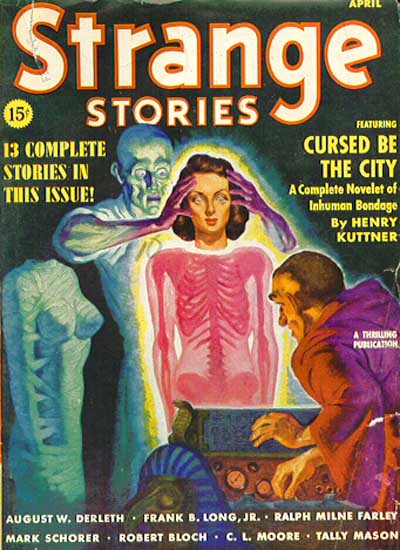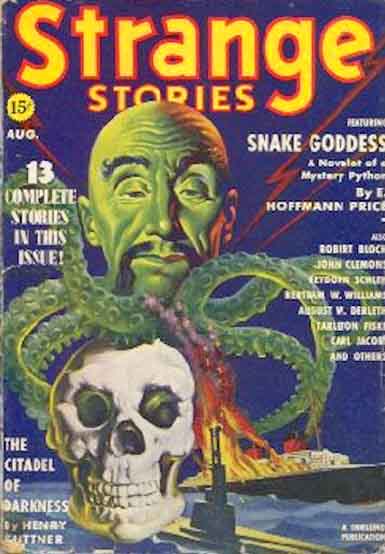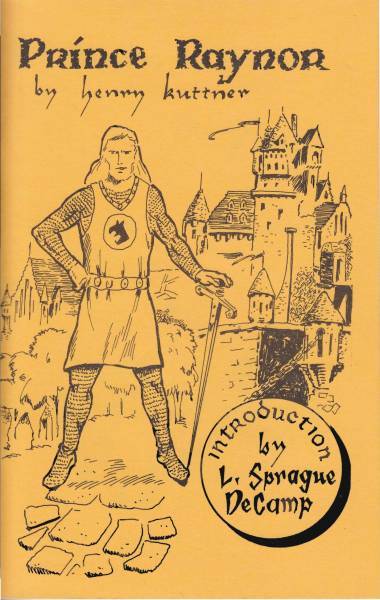 In January 1939, had you perused the magazines stands, you would have seen a new pulp magazine, Strange Stories. The magazine was published by Better Publications, the company that put out the pulp magazines with “Thrilling “ in the title.
In January 1939, had you perused the magazines stands, you would have seen a new pulp magazine, Strange Stories. The magazine was published by Better Publications, the company that put out the pulp magazines with “Thrilling “ in the title.
Strange Stories was a bimonthly magazine that lasted for 13 issues February 1939 to February 1941. 132 pages and sold for $.15, $.10 less than Weird Tales. Mort Weisinger was probably the editor under Leo Margulies.
As a weird fiction magazine set up to compete against Weird Tales, it attracted Weird Tales writers. C. L. Moore, August Derleth, Manly Wade Wellman, E. Hoffmann Price, Robert Bloch, and Carl Jacobi were all present in Strange Stories.
Henry Kuttner was present in seven out of those thirteen issues that we know of. Better Publications liked to use stories under house pseudonyms by various writers.
In 1937, Henry Kuttner wrote a letter to Clark Ashton Smith about he had written two stories about Alfred (King Alfred of Wessex?) rejected by Farnsworth Wright, editor at Weird Tales. Kuttner then turned around and wrote what he thought was a parody of the wandering swordsman trope. The result was Elak of Atlantis which Kuttner thought Wright had the poor taste to purchase. Wright’s capriciousness never ceases to amaze. Kuttner ended up with four Elak of Atlantis stories in Weird Tales.
He had a second sword and sorcery series– Prince Raynor. “Cursed Be the City” was in the second issue of Strange Stories (April 1939). Kuttner sets things up with his own version of “The Nemedian Chronicles.”
“This is the tale they tell, O King: that ere the royal banners were lifted upon the tall towers of Chaldean Ur, before the Winged Pharaohs reigned in secret Aegyptus, there were mighty empires far to the east. There in that vast desert known as the Cradle of Mankind– aye, even in the heart of the measureless Gobi– great wars were fought and high palaces thrust their minarets up to the purple Asian sky. But this, O King, was long ago, beyond the memory of the oldest sage; the splendor of Imperial Gobi lives now only in the dream of minstrels and poets. . .
–The Tale of Sakhmet the Damned”
“Cursed Be the City” opens with the fall of the city of Sardopolis. King Cyanares, the conqueror of Sardopolis, kills King Chalem of Sardopolis for refusing to bend at the knee. Chalem’s son, Prince Raynor, likewise refuses to submit and is sent to the torture chamber to learn the error of his ways.
Prince Raynor is described as “a tall, well-muscled figure, yellow-haired, with a face strong despite its youth, now darkened with rage.”
Chapter II opens with the line “Prince Raynor was acutely uncomfortable. He was stretched on a rack.” Kuttner was later known for humor but you don’t know if he was attempting humor or just engaging in clunky pulp prose. Raynor’s servant, Eblik the Nubian rescues him from the dungeon. The duo made their escape through a tunnel from the Temple of Ahmon. A dying priest gives them a talisman to release a terrible god imprisoned by Ahmon, thereby fulfilling a prophecy.
During a fight with Cyanxares’ men, Raynor is described using a rapier.
There is an interlude at a Reaver stronghold where the daughter of the leader guides Raynor and Eblik to the Valley of Silence. Raynor joins his portion of the talisman to another piece on an altar. The god Pan is released. Meanwhile, Cyaxares has followed with a large force on the heels of Raynor.
The Reaver’s castle collapses under Pan’s assault. Prince Raynor, Eblik, and Delphia watch the city of Sardopolis collapse as Pan returns to the site of his first alter. Pan is never shown on stage, he/it is a force of destructive nature.
Like Elak, Raynor is barely described. The setting is boiler plate high medieval with little description going on. Like the Elak stories, the supernatural element is very strong, to the point of dwarfing the main character.
 Prince Raynor returned in “Citadel of Darkness” for the August 1939 issues of Strange Stories. Raynor and Eblik return to a camp of refugees of Sardopolis to find them dead. Delphia is missing. Ghiar gives Raynor an amulet to use against Malric.
Prince Raynor returned in “Citadel of Darkness” for the August 1939 issues of Strange Stories. Raynor and Eblik return to a camp of refugees of Sardopolis to find them dead. Delphia is missing. Ghiar gives Raynor an amulet to use against Malric.
A mysterious old man in a robe emerges from the shadows, Ghiar. He directs Raynor and Eblik to Baron Malric’s castle, the perpetrator of the massacre. Raynor and Eblik enter Malric’s castle during a celebration and challenge Malric. Raynor uses the amulet which freezes Malric and his men. Ghiar then arrives and abducts Delphia while knocking out Raynor and Eblik through sorcery.
Eblik awoke first and got information from one of Malric’s men on the location of Ghiar’s citadel. The two infiltrate Ghiar’s castle while dealing with several sorcerous defenses of Ghiar’s citadel. There is a final showdown with Ghiar with Malric and his henchmen arrived for the party. Raynor perseveres using Ghiar’s amulet against him. Again, this story is strong on the supernatural element in the climax.
Kuttner does not strike you as having deep love for history the way Robert E. Howard had. You can imagine the Prince Raynor stories looking like an early 1950s historical like Prince Valiant with generic medieval costumes, armor, weapons, and castles.
There were no more tales of Prince Raynor. Strange Stories would run a couple of more sword and sorcery stories by Lloyd Arthur Eshbach and a story with a classical Roman stetting by Robert Bloch. After that, sword and sorcery died out in Strange Stories.
Lin Carter would reprint “Cursed Be the City” in the anthology The Young Magicians (1969). L. Sprague de Camp reprinted “Citadel of Darkness” in Sword and Sorcery (1963), the very first sword and sorcery anthology. Gryphon Books reprinted both in Prince Raynor (1987). Karl Edward Wagner reprinted both stories in Echoes of Valor III (1991). The two Raynor stories were bundled in with Elak in Paizo’s Elak of Atlantis (2007). The Paizo edition is still available for $12.99.
Karl Edward Wagner had this to say about the Prince Raynor stories in Echoes of Valor III:
“While not strictly in the Howard mold– Kuttner’s stories more closely call to mind Michael Moorcock’s Elric series of the present day– he was the best of those who sought to fill the gap left by Howard’s death.”
I would be interested in hearing people’s opinions on the wandering swordsman cliche that Kuttner thought he was parodying with Elak. Was it Conan? Or was it Dumas, Sabatini, or others?

“Ghiar gives Raynor an amulet to use against Malric.”
Of course, the names “Malric” and “Raynor” had no influence upon Moorcock’s “Elric” and “Gaynor”. None whatsoever.
While the stories have their share of faults, IMO, I still like them better than Kuttner’s Elak tales.
Great observations, Morgan. Raynor is great fun although he never would have existed but for Howard and Merritt. The two stories also crib directly from plot devices in Howard. The supernatural doom in “Cursed Be the City” is lifted from “Worms of the Earth,” the deformed being who helps Raynor in “Citadel of Darkness” from “The Tower of the Elephant.” Younger fantasy readers accustomed to today’s stripped-down prose style may like Kuttner better than they do Howard.